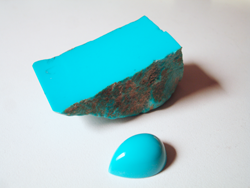If cold December gave you birth,
The month of snow and ice and mirth,
Place on your hand a turquoise blue;
Success will bless whate'er you do.
According to the Kansas City list, December has a few choices (turquoise, blue zircon, tanzanite; lapis lazuli prior), but we'll start with turquoise.
Turquoise is a secondary mineral; instead of forming under heat and pressure like silicates, diamonds, or corundum, it's the result of weathering and oxidation on copper deposits. Its chemical formula is CuAl6(PO4)4(OH)8·4H2O, making it a hydrate. On a microscopic level, turqouise looks something like this:
If you want to peek at most of the modern Kansas City birthstones under an Internet microscope (metaphorically), this Japanese website (in English) has a really handy list!
Turquoise forms in arid regions with histories of volcanic activity, and because its formation is highly irregular, the stone can vary significantly in its color and characteristics. Thus, it's become common to refer to turquoise by its mine or place of origin, as turquoise pieces from the same mine share similar characteristics.
 |
| Sleeping Beauty Turquoise |
 |
| Kingman Turquoise |
 |
| Bisbee Turquoise |
Turquoise is one of the oldest precious stones known to civilization and was found and used all around the world, even in ancient times. The ruling classes in pre-Columbian Mesoamerica, Egypt, Persia, Tibet, and China (just to name a few) used it as adornment and often as a magical talisman or good luck charm. The oldest known turquoise mine was operating in Egypt as far back as 5500 BCE.
The English word turquoise comes from an Old French word for "Turkish," turqueise. World-renowned for thousands of years, turquoise nonetheless did not make its way to Europe until well into the Common Era via Turkey, though the stone itself originated in mines in Iran. Other, older names for turquoise include callais (according to Pliny the Elder), pirouzeh (Persian, "victory/victorious"), firouzeh (Arabic), and teoxihuitl (Aztec).
Since it's such an old stone, traditions and beliefs about turquoise abound. In Ancient Persia it was believed to be a talisman against, and also a harbinger of, death: it was worn for protection, and a change in the color was believed to be a warning of imminent doom. Turquoise can absolutely change color, but this is the natural result of exposure to radiation (even just sunlight) or chemical reactions with cosmetics, perfumes, or the oils of the skin.
The Zunis and Apache tribes in the New World also sported turquoise. According to Apache lore, turquoise improved aim. The Zunis believed that it improved a horse's sure-footedness and prevented the rider from being injured from a fall or throw.
Turquoise is a soft, porous mineral—about a 6 on the Mohs scale. It can absorb perfumes and scents very easily; if turquoise is going to be part of your ensemble on a night out, apply any perfumes/hair sprays/etc. before putting on your jewelry. Do not store turquoise in airtight containers (like opal, it needs some ambient moisture), and be careful not to leave it with particularly malodorous items, lest it pick some of it up. It is also very susceptible to the solvents used in most cleaning solutions; instead, it's best to clean turquoise with a soft toothbrush and plain water.
Because turquoise is so soft, it often undergoes treatments to increase its hardness and durability. These include waxing and oiling (using wax or oil to fill the natural fissures of the stone), backing (using adhesive to attach a thin slice of turquoise to a more durable back), and stabilization (similar to waxing and oiling, but using an epoxy or sodium silicate instead). Dull pieces are often dyed with Prussian blue to enhance their color. Gemologists can determine what treatment a stone has been subjected to, but those tests are often destructive (ruining the color of whatever portion is tested). There is also reconstituted turquoise: flakes and turquoise powder useless on its own combined and suspended in a resin. This often referred to as "block" turquoise, or sometimes just "block."
Naturally, turquoise being so popular, it is often imitated. Not all reconstituted turquoise contains any turquoise at all: often, block turquoise is nothing but resin and dye. Howlite, a white, porous stone with gray veins, is often dyed to resemble turquoise. Some stores are up front about this and some are not. I've also noticed that people on Etsy will tag anything veiny and light blue as turquoise, though if you read carefully it's "turquoise variscite" or "teal howlite" or whatever. Read those item descriptions carefully! And there is no such thing was "white turquoise": I suspect that's a sexed-up term for howlite.



I was born in December. I have always loved the stones connected to my birth month!
ReplyDeleteThey are all quite lovely and rich in color!
Delete